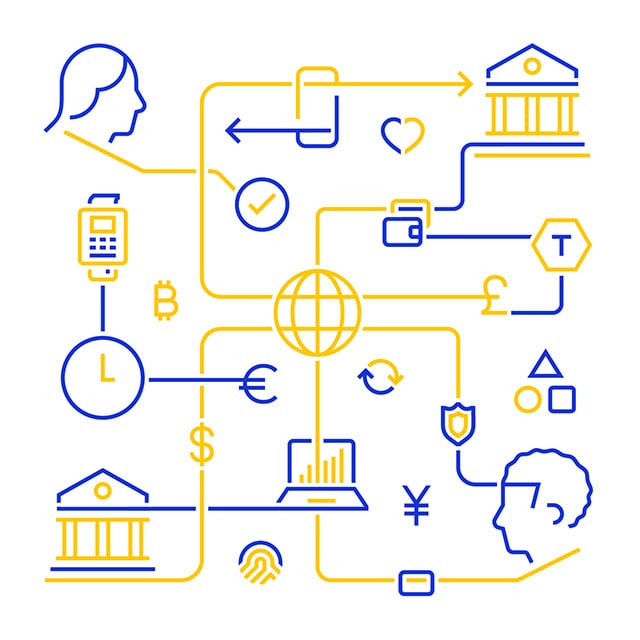Money movement from Me2Me
Where do people keep their money? For hundreds of years, the answer to that question was invariably a single place. A bank. A brokerage house. A mattress. Until recently, money didn’t have much in the way of velocity. It was a simple equation: you stored your money in one place until you needed to withdraw it.

Expectations are changing about where and when consumers can access their own money. Gen Z increasingly wants their banks and financial institutions to behave more in line with their experiences with the digital native apps they’re accustomed to,⁴ with an emphasis on convenience, ease of use, and speed. 59% of U.S. Gen Z adults surveyed said that their go-to payment method was whatever is easy and convenient, a number that dwarfs the desire to earn credit card rewards (15%) or control their spending (23%).⁴ That means that the next generation of consumers are poised to choose financial services that make accessing their own money—wherever it is—easy and fast.
“We live in a world with expectations of immediacy and convenience – whether that’s searching for a new show to watch, or the ability to quickly send funds to friends and family. Yet, when it comes to moving funds between one’s own accounts, too often the process can still be harder than it should be,” says Anastasia Serikova, Head of Visa Direct, Europe. “With Visa Direct, financial institutions and modern fintechs can give their customers the speed, convenience, and flexibility they want with real-time payments to eligible accounts, debit or reloadable prepaid cards and a simple digital experience.”⁵

A Step in the Right Direction
“In some ways, Gen Z is more financially empowered than most other generations—and that comes with increased levels of stress. Are you doing the right things? Are you taking the right considerations? Are you making the right decisions at different points and times?” says Horacio Diaz Adda, CFO of Step, a financial services startup with a suite of services tailored to the expectations and needs of Gen Z. Managing finances is a major burden for younger generations, with 67% of Gen Z respondents saying they’re stressed about their financial situation and 38% reporting that day-to-day finances are a top contributor to their stress.⁴
For Gen Z, their financial journey can include an increasingly diverse and complex set of considerations and options, like the new credit landscape or alternative investment opportunities like cryptocurrency. That’s why Step is continually evolving their product and adding new offerings to their platform in response to those demands, and the ability to seamlessly transfer funds across their own financial accounts will no doubt play a vital role in the financial empowerment of Gen Z and Step’s success.
“We've added the ability for our users to save money, and we're working on the ability for our users to invest money both in the stock market and cryptocurrencies,” says Adda. “And we’re continually thinking about opportunities to connect our platform to as many other platforms as possible so that customers feel that they have immediate access to their money."

The convenience and speed of Visa Direct’s network are vital differentiators for Step and its customers. Step’s ability to move funds quickly is enabled by Visa Direct’s payment infrastructure, through Step’s financial institution, which helps the fintech company connect funding bank accounts using eligible card credentials to the platform for deposits.
“Visa Direct has been a huge partner to us,” says Adda. “We’re dealing with families, and families sometimes have emergencies. The ability to move $50 or $100 very quickly because it's needed right now for a very specific thing is a massive benefit for our customer.”
A new frontier for banks
Step is part of a new generation of financial institutions listening to the demands of digitally native consumers, but they aren’t alone. “Neobanks” are an emerging set of technology companies that combine the customer-centric UX of mobile applications with traditional financial services like issuing debit cards, providing interest-bearing savings accounts, or facilitating stock trades. There are now hundreds of neobanks⁶ around the world—and as a group, they saw $66 billion worth of revenue in 2022.⁷
Neobanks are also increasingly using the ease of their account-to-account transfers to attract new users. Many neobank platforms are partnering with Visa Direct to enable their users to transfer money between currency-denominated accounts in real time¹ so that, for example, a German entrepreneur who travels between Berlin and London can easily and quickly swap euros for pounds. In a globalized economy, that sort of convenience is increasingly going from a desire to an expectation, with consumers flocking to tech-first banks that reflect their priorities.

Personal banking, reimagined
Neobanks aren’t alone in pushing forward the conversation around improved experiences in consumer finance. Traditional banks—some with millions of customers—are also turning to technology to help their existing customers manage their accounts and move their money as well as to attract the next generation. Banks have started to integrate P2P solutions and payment apps into their offerings, giving a consumer base hungry for digital solutions attractive options that combine the trustworthiness of established brands with the innovation of startups. But in many instances, helping clients access their own money—wherever it is—is lagging behind.
Visa Direct is helping banks and financial institutions modernize banking with solutions to make the process of sending money to oneself (and others) easier. Those financial institutions that make it easy to fund new accounts through account-to-account transfers are poised to attract a new generation of customers. According to a recent U.S. survey from Insider Intelligence, 36% of Gen Z and Millennial respondents said that the ability to fund new accounts through a payment app is extremely important, although none of the 14 U.S. banks or neobanks included in the study support that funding method yet. Funding with a debit card is also important for Gen Z, Millennial and even Gen X respondents, as stated by 31%, 34%, and 31% of respondents, respectively.²
Younger customers want options for funding new accounts
Different starting points
Some countries have more modern banking infrastructure than others, which can affect how easily (or not) money flows across accounts. Vipps, a Norwegian P2P and e-commerce payments platform, for example, has benefited from its domestic bank’s development of a united and uniform national data-reference system. That effort started decades ago, and it has yielded dividends for consumers and fintechs alike. “Banks in Norway built this sort of fintech company that structured data for the banks. This was the early computer age, and the infrastructure has since been continuously improved, and it has contributed to banks’ ability to perform effective money transfers and settlements between banks since,” says Baard Slaattelid, Strategic Partnerships at Vipps MobilePay. This robust reference system helps money within Norway flow more fluidly; due to uniform identifiers, consumers can send money to their own accounts or those of family and friends across banks with little friction.

Investing in real-time revenue
Brokerages are also seeing the value of allowing their customers to fund their accounts quickly. Currently, over 100 neobanks and more than 40 brokerages and trading platforms across the globe use Visa Direct to help their clients move money between accounts using eligible card credentials. Compared to personal banking accounts, brokerages often see a consistent inflow and outflow of funds as people buy and sell securities. The rise of UX-driven mobile trading platforms has made real-time¹ funding increasingly attractive for the growing number of retail traders who want to take advantage of fast-moving market conditions.⁸ Improving the fluidity of funds into and out of accounts with a partner like Visa Direct can potentially help brokerages attract customers and improve their bottom line.
The future of A2A
Building an ecosystem where fast, seamless A2A transfers are a reality will require a revolution in how banks, brokerages, and other financial institutions approach doing business. But they’ll need the infrastructure to enable that, which is where Visa Direct comes in. With the ability to provide real-time¹ payments to nearly 11B+ endpoints (e.g., cards, accounts, wallets) in 160+ currencies around the globe, Visa Direct is helping financial institutions give account holders more control over their money.

More Visa Direct thought leadership
Read more about global money movement, evolving digital payments trends, and Visa Direct clients
Endnotes
This article was published in August 2023.
- Actual fund availability depends on receiving financial institution and region.
- Insider Intelligence. U.S. account opening benchmark 2022. 1,105 U.S. checking-account openers in April 2022 to examine the mobile checking account opening features offered by the top 10 U.S. banks by domestic assets and the top four U.S. neobanks by users.
- 2022 Visa-commissioned global market sizing analysis that analyzed payment volumes for 26 use cases across 60 markets globally.
- Javelin Strategy & Research Advisory. Real-time payments: an urgent priority for financial institutions. Sponsored by Fiserv. 3,711 respondents were representative of the U.S. population. October 2021.
- Actual fund availability depends on receiving financial institution, receiving account type, region, whether transaction is domestic or cross-border, and other factors.
- McKinsey. Building a winning AI neobank. https://www.mckinsey.com/industries/financial-services/our-insights/building-a-winning-ai-neobank. November 2022.
- Grandview. Neobanking market size, share & trends analysis report. https://www.grandviewresearch.com/industry-analysis/neobanking-market. 2021.
- Forbes. Retail trading just hit an all-time high. Here’s what stocks are the most popular. https://www.forbes.com/sites/dereksaul/2023/02/03/retail-trading-just-hit-an-all-time-high-heres-what-stocks-are-the-most-popular/ February 2023.